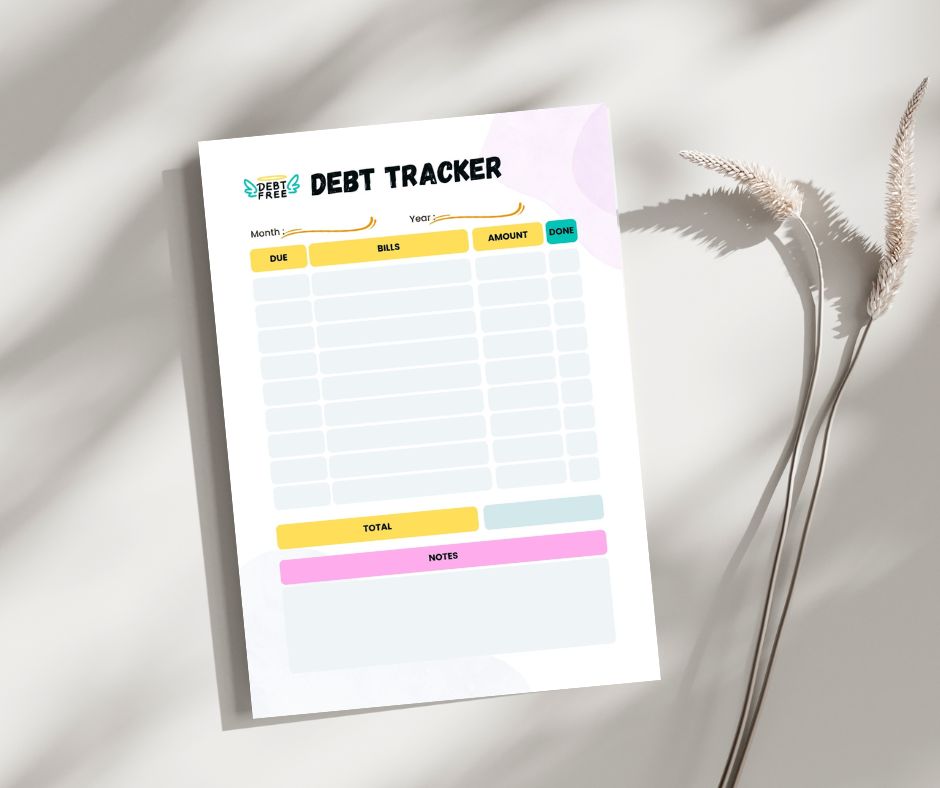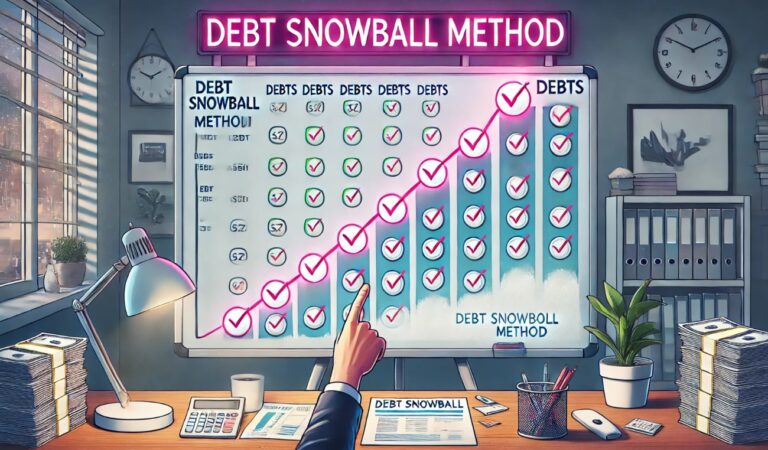Are you tired of feeling overwhelmed by your credit card debt? The Debt Snowball Method might be the game-changer you need. This powerful strategy, popularized by financial expert Dave Ramsey, has helped countless people regain control of their finances.
What is the Debt Snowball Method?
The Debt Snowball Method is a debt reduction strategy that focuses on paying off your smallest debts first, regardless of interest rates. By doing so, you gain quick wins and build momentum, making it easier to tackle larger debts.
Steps To Implement Ramsey’s Debt Snowball Method
Here’s how it works in detail according to Ramsey.
1. List Your Debts

Start by listing all your debts from the smallest to the largest balance.
This includes all forms of debt: credit cards, medical bills, personal loans, etc.
The idea is to organize your debts in a way that makes it easier to tackle them one at a time.
Example:
- Credit Card A: $500
- Credit Card B: $1,200
- Credit Card C: $4,000
- Credit Card D: $2,500
By arranging your debts from the smallest to the largest balance, you create a clear and manageable plan. This method helps you to focus on one debt at a time, making the process less overwhelming.
Seeing the smallest debt first provides a psychological boost when you pay it off quickly. This sense of accomplishment fuels your motivation to continue tackling the next debt on your list.
2. Create a Budget
Next, create a budget to track your income and expenses. Knowing where your money goes each month is crucial for identifying opportunities to free up funds for debt repayment.
Example: If you earn $3,000 per month, your budget might look like this:
- Rent: $1,000
- Utilities: $200
- Groceries: $300
- Transportation: $200
- Miscellaneous: $300
- Minimum credit card payments: $300
In this scenario, your total expenses are $2,300. This leaves you with $700 that can be allocated towards debt repayment.
Step-by-Step Budget Creation:
- Track Your Income: List all sources of income, such as your salary, freelance work, or any other income streams.
- Track Your Expenses: Write down every expense, from fixed costs like rent and utilities to variable costs like groceries and entertainment.
- Categorize Spending: Group your expenses into categories such as housing, utilities, food, transportation, and miscellaneous.
- Identify Savings Opportunities: Look for areas where you can cut back. For example, you might reduce dining out, find a cheaper phone plan, or cut down on subscription services.
- Allocate Extra Funds: Use the money saved from cutting expenses to pay down your debt more aggressively.
Creating a detailed budget helps you understand your financial situation better. It shows where you can make adjustments to increase the amount available for debt repayment.
By consciously managing your money, you can accelerate your progress in paying off your debts using the Debt Snowball Method.
3. Build a $1,000 Emergency Fund
Before you start paying down debt, save $1,000 for emergencies. This step is crucial because it creates a financial cushion that prevents you from relying on credit cards for unexpected expenses like car repairs, medical bills, or home repairs.
Example: Suppose your car suddenly needs a $500 repair. Without an emergency fund, you might put this expense on a credit card, increasing your debt. With a $1,000 emergency fund, you can cover the repair without adding to your debt, keeping your debt reduction plan on track.
Step-by-Step Emergency Fund Creation:
Step 1: Set a Goal
Aim to save $1,000 as quickly as possible. This amount is a starter emergency fund that covers most small to medium unexpected expenses.
Step 2: Cut Back Temporarily
Look for ways to reduce spending in your budget temporarily. For example, you might skip dining out, postpone non-essential purchases, or find a temporary side job to boost your income.
Step 3: Automate Savings
Set up an automatic transfer from your checking account to your savings account. Even small, regular transfers can add up quickly.
Step 4: Prioritize
Make saving for your emergency fund a priority. Treat it as an essential part of your financial plan, not just an afterthought.
Having this emergency fund in place means you won’t derail your debt repayment efforts when life’s unexpected expenses arise. It provides peace of mind and financial stability, allowing you to stay focused on eliminating your debts using the Debt Snowball Method.
4. Pay the Minimum Payments on All Debts Except the Smallest
To effectively utilize the Debt Snowball Method, it’s important to maintain the minimum payments on all your debts except the smallest one. This ensures that you stay current on all your accounts and avoid late fees or penalties, which can derail your progress.
Example: Imagine you have the following debts:
- Credit Card A: $500 (smallest debt)
- Credit Card B: $1,200
- Credit Card C: $4,000
- Credit Card D: $2,500
For Credit Cards B, C, and D, you will continue making the minimum payments. Let’s assume the minimum payments are:
- Credit Card B: $50
- Credit Card C: $100
- Credit Card D: $75
This totals $225 per month for these three cards.
Step-by-Step Process:
Identify Minimum Payments:
Determine the minimum payment required for each of your debts. This information is usually available on your monthly statements.
Ensure Payments Are Made:
Set up automatic payments or reminders to ensure you never miss a minimum payment. This keeps your accounts in good standing and protects your credit score.
Focus on the Smallest Debt:
Any extra money you have after making these minimum payments will go towards paying off the smallest debt (in this case, Credit Card A).
Why This Works: By paying only the minimum on larger debts, you prevent further accumulation of interest and fees. Focusing your extra funds on the smallest debt allows you to pay it off quickly. This quick win provides a psychological boost, reinforcing your commitment to the debt repayment process.
Maintaining minimum payments on all other debts while targeting the smallest one creates a disciplined and manageable approach. It ensures that you’re reducing your overall debt without falling behind on any accounts, keeping you on a steady path towards financial freedom.
5. Attack the Smallest Debt
After ensuring that you have made the minimum payments on all other debts, direct any extra money you have towards paying off the smallest debt first. This approach allows you to eliminate debts quickly, gaining a sense of accomplishment and momentum.
Example: Suppose you have $700 available after covering your monthly expenses. After making the minimum payments on Credit Cards B, C, and D (totaling $225), you have $475 left.
- Smallest Debt: Credit Card A with a balance of $500.
- Minimum payment for Credit Card A: $25.
Step-by-Step Process:
- Calculate Extra Funds: Determine the amount left after making the minimum payments on all other debts. In this example, you have $475 available.
- Combine Payments: Add the minimum payment for the smallest debt (Credit Card A) to your extra funds.
- $475 (extra funds) + $25 (minimum payment) = $500.
- Pay Off the Smallest Debt: Apply this total amount towards Credit Card A.
- Month 1: Pay $500 towards Credit Card A, which exactly covers the balance.
By directing your extra funds towards the smallest debt, you pay it off quickly. In this example, you completely eliminate the $500 balance on Credit Card A in just one month.
Why This Works:
- Quick Wins: Paying off a debt quickly provides immediate satisfaction and a psychological boost, motivating you to continue the process.
- Reduced Number of Debts: With each debt you eliminate, you reduce the number of payments you need to manage, simplifying your financial situation.
- Increased Cash Flow: Once a debt is paid off, the money you were using for that payment is now freed up to apply to the next smallest debt.
Attacking the smallest debt with all available extra funds allows you to make significant progress in a short amount of time.
This strategy not only helps in reducing your debt balance but also reinforces positive financial habits and keeps you motivated throughout your debt repayment journey.
6. Move to the Next Debt
Once you’ve paid off your smallest debt, you now have extra funds available each month that were previously allocated to that debt. The next step is to take this amount and apply it to the minimum payment of your next smallest debt. This creates a compounding effect, or a “snowball,” allowing you to pay off each subsequent debt faster.
Example:
- You have successfully paid off Credit Card A ($500).
- Now, you redirect the $500 you were paying on Credit Card A to Credit Card B, your next smallest debt.
Step-by-Step Process:
- Identify the Next Smallest Debt: After paying off Credit Card A, Credit Card B ($1,200 balance) is now your smallest debt.
- Combine Payments: Add the $500 you were paying on Credit Card A to the $50 minimum payment for Credit Card B.
- New total payment for Credit Card B: $550.
- Apply the Payment: Make a $550 payment to Credit Card B each month until it is paid off.
Example progress in this stage:
Month 1:
Balance: $1,200
Payment: $550
Remaining Balance: $650
Month 2:
Payment: $550
Remaining Balance: $100
Month 3:
Payment: $100 (final payment)
Credit Card B is now paid off.
By using the amount freed up from paying off Credit Card A, you significantly reduce the balance on Credit Card B in just two months, with a small final payment in the third month.
Why This Works.
- Accelerated Debt Reduction: Each time a debt is paid off, you have more money available to apply to the next debt, speeding up the repayment process.
- Motivation and Momentum: Seeing debts disappear quickly keeps you motivated to continue, reinforcing positive financial behavior.
- Financial Discipline: This method requires and builds financial discipline, as you consistently allocate funds towards debt repayment without reverting to previous spending habits.
Continue this process:
- Once Credit Card B is paid off, take the $550 and add it to the minimum payment for Credit Card D (next smallest debt).
- Original minimum payment for Credit Card D: $75
- New total payment for Credit Card D: $625
Repeat this method until all your debts are paid off. This snowball effect allows you to gain momentum, pay off debts faster, and ultimately achieve financial freedom.
7. Repeat Until All Debts Are Paid
As you continue to pay off each debt, you build momentum and free up more money to tackle the next one. This process is repeated until all your debts are eliminated.
The key is to keep the “snowball” rolling, applying the full amount from your previous debt payment to the next smallest debt on your list.
Example: You have successfully paid off Credit Cards A and B. Now, move on to Credit Card D (next smallest debt) and finally Credit Card C.
Bottom Line
By repeating this process until all your debts are paid off, you systematically eliminate your financial obligations. The Debt Snowball Method not only helps reduce debt but also instills disciplined financial habits that can lead to long-term financial stability and freedom.


